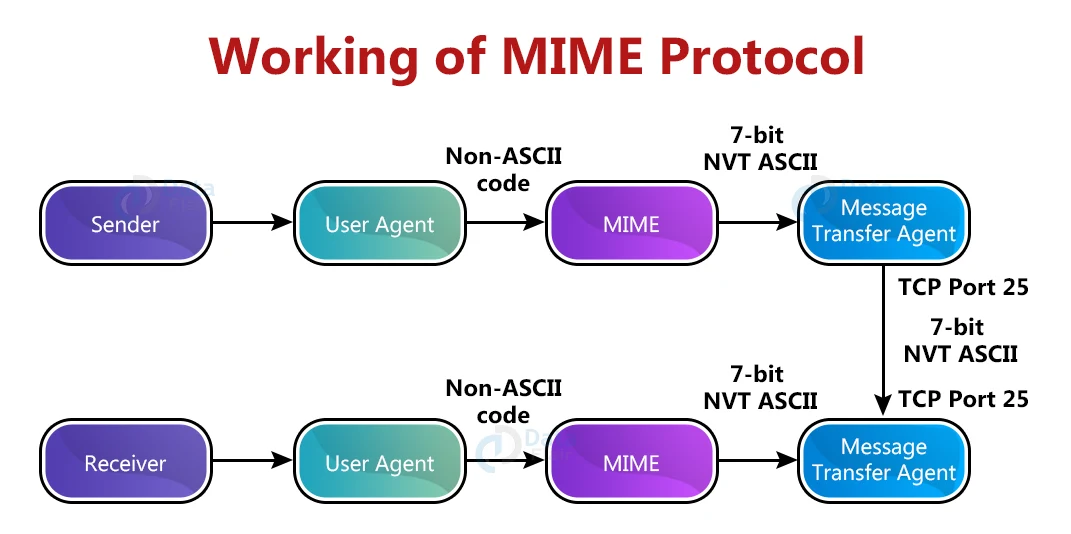MIME Protocol – Multipurpose Internet Mail Extensions
We offer you a brighter future with FREE online courses - Start Now!!
What is MIME?
MIME is short for Multipurpose Internet Mail Extensions. It is used to enhance the capability of Internet e-mail protocols like SMTP. The MIME protocol enables users to communicate many forms of digital information via email, such as images, audio, video, and other types of documents and files. MIME was developed in 1991 at Bell Communications by a computer scientist named Nathan Borenstein.
MIME is an e-mail extension protocol, which means that it does not work alone, but rather collaborates with other protocols such as SMTP to enhance the capabilities of e-mail. It can only transport text-based files of a restricted size in the English language through the internet. It is now utilised by virtually all email service providers, including Gmail, Yahoo-mail, and Hotmail.
Need for MIME Protocol
MIME protocol is used in computer networks to transport e-mail for the following reasons:
1. In email, the MIME protocol supports a variety of languages, including Hindi, French, Japanese, and Chinese.
2. Simple protocols can reject mail that exceeds a particular size restriction, but MIME has no word limit.
3. Images, music, and video cannot be transmitted using standard e-mail protocols like SMTP. These necessitate the MIME protocol.
4. Emails are frequently constructed using code such as HTML and CSS, and they are mostly used by businesses to promote their products. This sort of programming employs MIME to deliver HTML and CSS-based emails.
Features of MIME Protocol:
1. It allows you to include numerous attachments in a single email.
2. It accepts non-ASCII characters.
3. It allows for an infinite length of email.
4. It supports a variety of languages.
Working of MIME Protocol:
Consider the following scenario: a user wishes to send an email via the user agent, but the email is in a non-ASCII format. So, in this case, we utilise the MIME protocol to transform this non-ASCII format into the 7-bit NVT ASCII format.
The message is sent via email to the other side in the 7-bit NVT ASCII format, and then the MIME protocol converts it back to Non-ASCII code. at the receiver’s end, so that the receiver may read it.
MIME Header:
MIME extends the characteristics of the basic email protocol by adding five more fields to the header part of the actual email. It adds the following fields to the header:
1. MIME Version:
It specifies the MIME protocol version. This header typically has a parameter value of 1.0, indicating that the message is MIME-formatted.
2. Content-Type:
It specifies the kind and subtype of data that will be transmitted in the message. These communications can be of various sorts, including text, picture, audio, and video, and they can also have several subtypes, such as png or jpeg. Similarly, the Video subtype might be WEBM, MP4, and so forth.
3. Content Type Encoding:
This field specifies the technique used to transform mail information into ASCII or Binary numbers, such as 7-bit encoding, 8-bit encoding, and so on.
4. Content ID:
A unique “Content Id” number is attached to every email messages in this field so that they may be uniquely recognized.
5. Content Description:
This section includes a brief summary of the email’s content. This implies that the “Content Description” clearly contains information about whatever is being mailed. This field also contains data about the file’s name, creation date, and modification date.
Advantages of MIME Protocol:
1. It may transfer many sorts of data in a message, including text, audio, and video files.
2. It also allows you to send and receive emails in a variety of languages, including Hindi, French, Japanese, and Chinese.
3. It also allows individuals to link HTML and CSS to email, allowing them to customise email according to their needs and make it pleasant and elegant.
4. It can convey information included in an email regardless of its length.
5. It gives each email a unique id.
Summary:
In this article, we looked at the concept of the MIME Protocol, along with its characteristics and working. We also covered the MIME Header in detail, and also the various advantages offered by the MIME Protocol.
We work very hard to provide you quality material
Could you take 15 seconds and share your happy experience on Google


